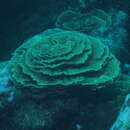Biology
provided by World Register of Marine Species
zooxanthellate
van der Land, J. (ed). (2008). UNESCO-IOC Register of Marine Organisms (URMO).
- license
- cc-by-4.0
- copyright
- WoRMS Editorial Board
Description
provided by World Register of Marine Species
Coralla form thick leaves. Both when seen living and cleaned, the corals tend to have a glassy, shiny or glossy appearance. The leaves have ridges which radiate outward from the centre towards the edge, while smaller ridges run parallel to the edge of the leaves. In older parts of colonies, the ridges may lead to an almost cerioid form, with one or two calices only being enclosed within the ridges. In the calices, septo-costae are more widely spaced than in most Leptoseris, though lower orders of septa join them outside the centres, to produce a typical septo-costal pattern. This is common on most reefs at depths below 20 m deep. (Sheppard, 1998 ) Colonies are laminar plates, in whorls or tiers or vase-shaped. Corallites are situated between radiating ridges of folds and are separated by secondary folds parallel to the margins. Septo-costae alternate and are exsert. Colour: usually pale brown or yellowish, sometimes with white margins. Abundance: Common on flat substrates. Colonies may exceed 1 m in diameter and are usually conspicuous. (Veron, 1986 )
Roux, J.P. (2001) Conspectus of Southern African Pteridophyta. Southern African Botanical Diversity Network Report 13 Page 118 (Includes a picture).
- license
- cc-by-4.0
- copyright
- WoRMS Editorial Board

